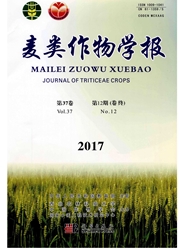

 中文摘要:
中文摘要:
为了解大麦种质材料的遗传多样性,并为合理选择育种亲本及保护与利用大麦种质资源材料提供依据,采用21对SSR荧光标记引物对来自19个亚洲国家的175份大麦种质材料进行遗传多样性分析,筛选出的19对SSR引物共检测到134个等位变异,平均每对引物检测到7.05个等位变异,其中SSR17位点对亚洲大麦基因组DNA变异检测最有效,其多态性信息含量指数(PIC)和标记指数MI均最高,分别为0.9和10.77;基于SSR数据,对19个亚洲国家175份大麦材料进行UPGMA聚类分析,结果聚为三组:组群Ⅰ共包含19个国家的161个品种;组群Ⅱ共包含4个国家的12个品种;组群Ⅲ只包括来自土库曼斯坦的2个品种。根据按国家划分的19个群体的遗传一致度数据,聚类分析可以分为3组群(其中组群1可分为4个亚组),主坐标分析可分为3个组群和7个亚组。本研究表明,聚类法和主坐标分析法结果基本吻合,均表明亚洲大麦种质资源存在丰富的变异,但主坐标分析法更精细。
 英文摘要:
英文摘要:
Understanding the genetic diversity of barley germplasm could be the basis for appropriate selection of parents in breeding program,and could enhance protection and utilization of barley germplasm.In this study,genetic diversity analysis of 175 barely accessions from 19 Asian countries was analyzed by 21 combinations of fluorescent SSR primers.The polymorphic information content(PIC) and marker index(MI) were calculated for each SSR primer.According to the genetic similarity,the polygenetic tree of the genetic relationship among the 175 barley accessions was drawn.According to the Genetic identity(GI),the polygenetic tree and the charts of principle coordinates analysis of the genetic relationship in barley accessions from the populations of 19 countries were classified by origins.The results showed nineteen pairs of SSR primers amplified 134 allelic loci with 7.05 per SSR primer pairs among the 175 cultivars.The results indicated that locus SSR17 was effective to detect DNA variation among those barley accessions from Asian.The highest value of polymorphism information content(PIC) and marker index(MI) was 0.9 and 10.77,respectively.Based on the polymorphism data,175 barley accessions from 19 Asian countries were clustered into 3 groups.Group I contained 161 accessions from 19 countries,group II comprised 12 accessions from 4 countries,only 2 accessions from Turkmenistan were clustered into group Ⅲ.According to the Nei's genetic identity(GI),19 national populations were classified into 3 groups by UPGMA phylogenetic analysis,and group 1 was with 4 subgroups.By using principle coordinates analysis,these populations were clustered into 3 groups and 7 subgroups.Results indicated that the classification with the two methods was basically similar with identification of highly genetic diversity of Asian barley accessions,but the principle coordinates analysis could be better.
 同期刊论文项目
同期刊论文项目
 同项目期刊论文
同项目期刊论文
 期刊信息
期刊信息
